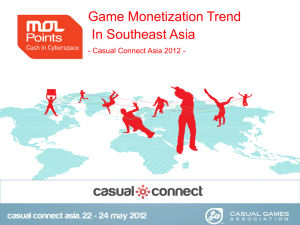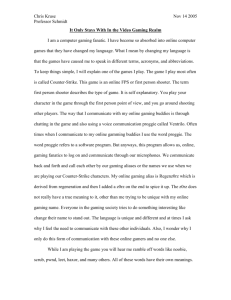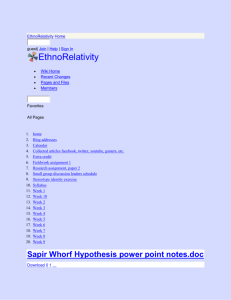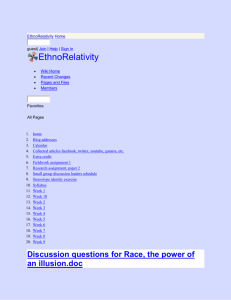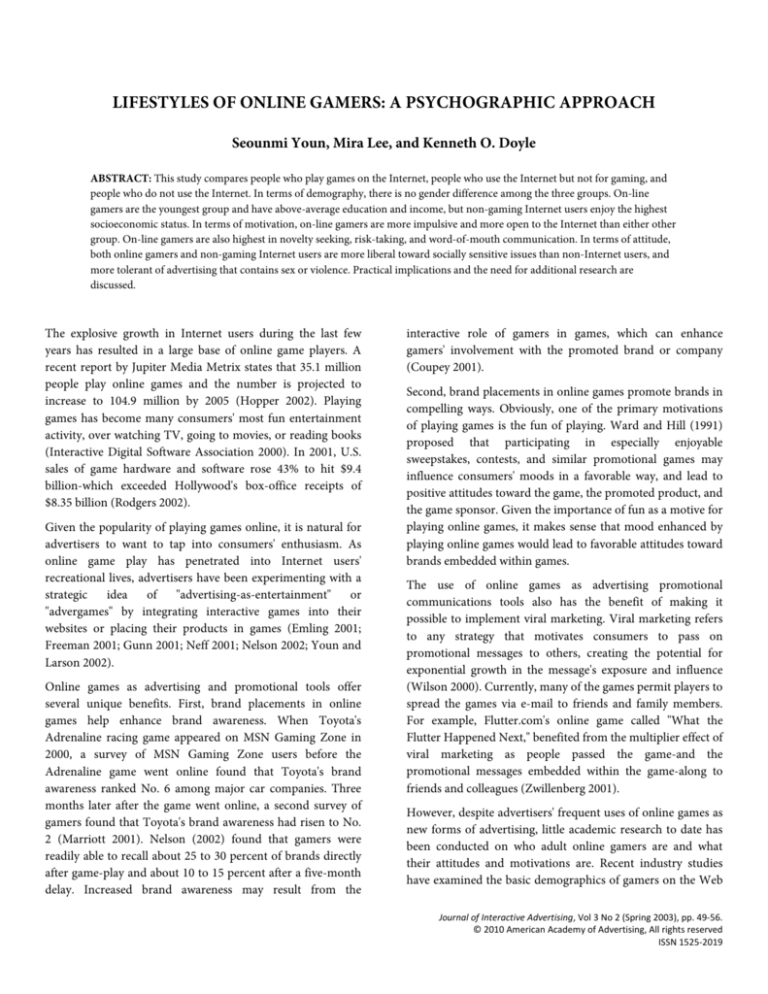
LIFESTYLES OF ONLINE GAMERS: A PSYCHOGRAPHIC APPROACH
Seounmi Youn, Mira Lee, and Kenneth O. Doyle
ABSTRACT: This study compares people who play games on the Internet, people who use the Internet but not for gaming, and
people who do not use the Internet. In terms of demography, there is no gender difference among the three groups. On-line
gamers are the youngest group and have above-average education and income, but non-gaming Internet users enjoy the highest
socioeconomic status. In terms of motivation, on-line gamers are more impulsive and more open to the Internet than either other
group. On-line gamers are also highest in novelty seeking, risk-taking, and word-of-mouth communication. In terms of attitude,
both online gamers and non-gaming Internet users are more liberal toward socially sensitive issues than non-Internet users, and
more tolerant of advertising that contains sex or violence. Practical implications and the need for additional research are
discussed.
The explosive growth in Internet users during the last few
years has resulted in a large base of online game players. A
recent report by Jupiter Media Metrix states that 35.1 million
people play online games and the number is projected to
increase to 104.9 million by 2005 (Hopper 2002). Playing
games has become many consumers' most fun entertainment
activity, over watching TV, going to movies, or reading books
(Interactive Digital Software Association 2000). In 2001, U.S.
sales of game hardware and software rose 43% to hit $9.4
billion-which exceeded Hollywood's box-office receipts of
$8.35 billion (Rodgers 2002).
Given the popularity of playing games online, it is natural for
advertisers to want to tap into consumers' enthusiasm. As
online game play has penetrated into Internet users'
recreational lives, advertisers have been experimenting with a
strategic
idea
of
"advertising-as-entertainment"
or
"advergames" by integrating interactive games into their
websites or placing their products in games (Emling 2001;
Freeman 2001; Gunn 2001; Neff 2001; Nelson 2002; Youn and
Larson 2002).
Online games as advertising and promotional tools offer
several unique benefits. First, brand placements in online
games help enhance brand awareness. When Toyota's
Adrenaline racing game appeared on MSN Gaming Zone in
2000, a survey of MSN Gaming Zone users before the
Adrenaline game went online found that Toyota's brand
awareness ranked No. 6 among major car companies. Three
months later after the game went online, a second survey of
gamers found that Toyota's brand awareness had risen to No.
2 (Marriott 2001). Nelson (2002) found that gamers were
readily able to recall about 25 to 30 percent of brands directly
after game-play and about 10 to 15 percent after a five-month
delay. Increased brand awareness may result from the
interactive role of gamers in games, which can enhance
gamers' involvement with the promoted brand or company
(Coupey 2001).
Second, brand placements in online games promote brands in
compelling ways. Obviously, one of the primary motivations
of playing games is the fun of playing. Ward and Hill (1991)
proposed that participating in especially enjoyable
sweepstakes, contests, and similar promotional games may
influence consumers' moods in a favorable way, and lead to
positive attitudes toward the game, the promoted product, and
the game sponsor. Given the importance of fun as a motive for
playing online games, it makes sense that mood enhanced by
playing online games would lead to favorable attitudes toward
brands embedded within games.
The use of online games as advertising promotional
communications tools also has the benefit of making it
possible to implement viral marketing. Viral marketing refers
to any strategy that motivates consumers to pass on
promotional messages to others, creating the potential for
exponential growth in the message's exposure and influence
(Wilson 2000). Currently, many of the games permit players to
spread the games via e-mail to friends and family members.
For example, Flutter.com's online game called "What the
Flutter Happened Next," benefited from the multiplier effect of
viral marketing as people passed the game-and the
promotional messages embedded within the game-along to
friends and colleagues (Zwillenberg 2001).
However, despite advertisers' frequent uses of online games as
new forms of advertising, little academic research to date has
been conducted on who adult online gamers are and what
their attitudes and motivations are. Recent industry studies
have examined the basic demographics of gamers on the Web
Journal of Interactive Advertising, Vol 3 No 2 (Spring 2003), pp. 49‐56. © 2010 American Academy of Advertising, All rights reserved ISSN 1525‐2019 50 Journal of Interactive Advertising Spring 2003
but do not provide us with information about motivational
and attitudinal characteristics of online gamers (Game
Research 2002). Understanding psychographic characteristics
of online gamers is useful as it adds to our knowledge about
the target audience advertisers can reach with online games.
Such an understanding is also very useful as it assists online
advertisers in identifying to whom and how to use online
games as advertising and promotional tools.
Thus, the purpose of this study is to profile adult online
gamers with regard to demographic, motivational, and
attitudinal characteristics, using 2001 DDB Life Style Survey
Data. Piirto (1991) observed that the Life Style Survey is
probably the most highly detailed consumer psychographic
database currently available. It consists of more than 1,000
questions on activities, interests, opinions, product use, and
media behavior. For the purpose of enriching profiles of
online gamers, this study divides non-gamers into nongaming Internet users and non-Internet users, and examines
how online gamers differ from non-gaming Internet users and
non-Internet users, leading to a three-group comparison.
LITERATURE REVIEW AND HYPOTHESES
DEVELOPMENT
Online gaming is a relatively recent occurrence. Indeed, the
first graphical browser for the World Wide Web was only
introduced in 1993. As a result, the number of published
academic studies regarding online gaming is very small. Due
to the lack of research on the profile of online gamers, we will
review both Internet user studies and offline gamer studies in
order to formulate hypotheses. It is assumed that those who
like both to use the Internet and to play games are more likely
to play games on the Internet.
Demographic Characteristics
Previous studies showed that Internet users differed from nonInternet users in age, education, and income (Coyle 1998;
Hoffman and Novak 1996; Howard, Rainie, and Jones 2001;
Korgaonkar and Wolin 1999). Overall, Internet users were
likely to be younger, to have college or higher degrees, and to
be better off financially than non-users. Earlier studies
revealed that men dominated Internet usage (GVU 1998;
Raman 1997), but a recent study found that the gender
difference became almost invisible (Wells and Chen 2000).
Regarding offline gaming behaviors, Youn and Lee (2002)
found that adult computer game players were relatively young
and well-educated people with above-average income. As with
the Internet users, gender gaps among adult computer gamers
were not noticeable. These considerations suggest the
following hypotheses:
H1a: Online gamers, along with non-gaming Internet
users, are likely to be younger, better educated, and earn
more income than non-Internet users.
H1b: There will be no gender difference between three
groups -- online gamers, non-gaming Internet users, and
non-Internet users.
Motivational Characteristics
Impulsiveness. Internet users visit the Web for specific
reasons (Raman 1997; Stafford and Stafford 1998). However,
most entertainment choices are likely to be made on the spur
of the moment because motivations of hedonic consumption
stem from intrinsic reward such as fun or pleasure, instead of
extrinsic reward such as monetary or instrumental incentives
(Deci 1975; Holbrook et al. 1984; Zillmann and Bryant 1994).
It is also likely that Internet users click the options or links for
games spontaneously from accidental exposure, curiosity, or
fad about new things. Based on these considerations, we
hypothesize that:
H2: Online gamers will be more impulsive than nongaming Internet users and non-Internet users.
Variety-Seeking and Risk-Taking. SRI International (1995)
observed that nearly seven out of ten Internet users have the
innovative, variety-seeking, and risk-taking personality type
(Donthu and Garcia 1999). Fifty percent of the Internet users
belong to the Actualizer segment (active and adventurous) and
18 percent belong to the Experiencer segment (innovative,
stimulation seekers, and fashionable). These findings indicate
that Internet users are more willing to try new things and are
less concerned with the risk involved with their new
consumption experiences. Because online gaming is a
relatively new phenomenon in the gaming consumption, this
novelty may attract innovative, variety-seeking and risk-taking
consumers.
In a study of promotional games, McDanial (2001) found that
a sensation-seeking personality trait was associated with
consumers' preferences for participating in contests or
sweepstakes. The findings imply that such promotional games
may help to meet consumers' need for varied, novel, or
stimulating experiences (Ward and Hill 1991). Studies in this
field have also speculated that promotional game participants
tend to have risk-taking personalities (Narayana and Raju
1985). Therefore, it is hypothesized:
51 Journal of Interactive Advertising Spring 2003
H3: Online gamers and non-gaming Internet users are
more likely to be variety seekers than non-Internet users.
H4: Online gamers and non-gaming Internet users are
more likely to be risk takers than non-Internet users.
Fun-Seeking. Numerous studies have found that among the
primary motives for using the Internet are entertainment
values, along with information values (Eighmey 1997;
Papacharissi and Rubin 2000). GVU's 10th WWW User
Survey showed that 35 percent of Internet users surf the
Internet to have fun and explore something (GVU 1998). Lee
(2001a) also discovered that "entertainment-seeking" is a
stronger predictor of the amount of Internet usage than is
"information-seeking." Among various entertainment
activities Internet users can choose on the Web, playing games
may be the most fun activity among many Internet users. One
industry study reported that the primary reason for people to
play games is because they are fun (Interactive Digital
Software Association 2000). Thus, we hypothesize that:
H5: Online gamers are most likely to be fun seekers,
followed by non-gaming Internet users, and non-Internet
users.
Word-of-Mouth. The Internet has been widely utilized as a
venue for voicing opinions, complaints, and recommendations
on brands, products, or companies (Chatterjee 2001). As
discussed earlier, especially, online games have the benefit of
making it possible to implement viral marketing (Zwillenberg
2001), by allowing online gamers to spread the games via email to friends and family. A recent survey on online gaming
habits reported that one of the motivations of playing online
games is to talk about games to friends (Game Research 2002).
Thus, it is hypothesized:
H6: Online gamers are most likely to engage in word-ofmouth communications, followed by non-gaming
Internet users and non-Internet users.
Attitudinal Characteristics
Liberalism. Wells and Chen (1999, 2000) found that Internet
users considered themselves more liberal and less conservative
than non-users. This suggests that Internet users are more
likely to have liberal attitudes toward socially controversial
issues such as abortion, same sex marriages, or use of
marijuana, to name a few. Regarding gaming activities, it has
been found that adult video and computer gamers are more
tolerant of socially sensitive issues than non-gamers (Youn
and Lee 2002). Thus online gamers would be more liberal
toward controversial social issues. Based on
observations, the following hypothesis is suggested:
these
H7: Online gamers and, to a lesser extent, non-gaming
Internet users will show more liberal attitudes toward
socially controversial issues than non-Internet users.
Attitude toward Advertising. In a similar vein, Internet users
have been found to be more tolerant of controversial content
in advertising (Wells and Chen 1999, 2000). Internet users
were more liberal toward alcohol advertising, advertising
directed to children, and sexual content in TV commercials.
Donthu and Garcia (1999) discovered that Internet shoppers
have a more positive attitude toward advertising. Further,
because online gamers have been frequently exposed to the
violent and sexual images presented in many games, they
would be more likely to be insensitive to violent or sexual
content in advertising. Thus, it is hypothesized that:
H8: Online gamers will hold most positive attitudes
toward advertising, followed by non-gaming Internet
users. Non-Internet users will show least positive attitudes
toward advertising.
Openness to the Internet. In Ducoffe's (1996) study, Internet
users stated that the Internet is a good source of up-to-date
product information, is useful, and is entertaining. Lee (2001b)
found that Internet shoppers use the Internet as the primary
source of information about products and brands. Youn and
Lee (2002) found that adult video and computer gamers have a
positive attitude toward the Internet. These observations
suggest the following hypothesis:
H9: Online gamers and non-gaming Internet users will be
more open to the Internet than non-Internet users.
METHOD
Data. We used data from the 2001 DDB Needham Life Style
Survey, an annual standing-panel quota sample similar to the
U.S. adult population in age, gender, income, geography, and
other demographics. Of 5,000 questionnaires, usable responses
were received from 1,368 males (44.8%) and 1,688 females
(55.2%). The Life Style Survey addresses a wide range of
questions about attitudes, interests, opinions, activities,
product use, and mass media use.
Measures. From the pool of items of the Life Style Survey, this
study identified the items that measure (1) online game
playing activity, (2) the use of the Internet, (3) demographic
factors, and (4) constructs expected to relate to online gaming
behavior in the literature review.
52 Journal of Interactive Advertising Spring 2003
One item asking respondents to indicate how often they have
engaged in online game during the past 12 months was
selected as an indicator of online game play. Another item
asking respondents whether or not they have used the Internet
in the past 12 months was also identified. By combining these
two items, this study divided respondents into three groups -online gamers, non-gaming Internet users, and non-Internet
users.
To explore demographic characteristics differentiating these
three groups, this study considered gender, age, education,
and income. Further, to determine differences and similarities
between these three groups, we examined the items from the
section of the Life Style Survey that assesses attitudes, interests,
and opinions. Due to the dearth of published studies on the
characteristics of adult gamers, we chose items reflecting
constructs of interest to consumer researchers in the field of
promotional games, motivations for Internet use, and
electronic gaming behaviors (Youn and Lee 2002). Each item
was measured by a six-point scale ranging from 1="definitely
disagree" to 6="definitely agree."
For data reduction, an exploratory factor analysis was
performed over selected items, with a Varimax rotation and
eigenvalues over 1.0. Negatively loaded items were reversecoded and reliability tests on each factor were conducted. To
improve internal consistency, items that lowered alpha were
discarded. After refinement of items, a factor analysis was
conducted again over the remaining items. Finally, this
analysis produced eight factors that generally conformed to
the expected pattern of constructs, accounting for 51.7% of the
total variance. Five of these factors described motivationVariety-Seeking, Impulsiveness, Word-of-Mouth, FunSeeking, and Risk-Taking-and three described attitudesLiberal Attitudes Toward Social Issues, Openness to the
Internet, and Skeptical Attitudes Toward Advertising. Alphas
ranged from .57 to .78, acceptable for exploratory studies
(Nunnally 1978). The one factor that did not meet this
standard was Risk-Taking, alpha .42. Appendix 1 presents
these factors and illustrative items. For the several retained
factors, we aggregated raw scores on each and preserved the
summed scores for further analyses.
RESULTS
Overall, the 2001 Life Style Survey data showed that about
two-thirds (66%) of total respondents had used the Internet in
the past 12 months, while about 40 percent of total
respondents had played a game on the Internet at least once in
the past year (see Table 1). Looking at the size for each group,
online gamers were 40 percent, non-gaming Internet users
were 26 percent, and non-Internet users were 34 percent,
respectively.
Demographics
The 2001 Life Style Survey data showed no gender difference
between online gamers, non-gaming Internet users, and nonInternet users, replicating findings from previous Internet user
studies (Wells and Chen 2000) and adult video/computer
gamers studies (Youn and Lee 2002). In terms of age, online
gamers were the youngest among three groups, implying that
younger online users are more likely to use the Internet for fun
(Howard, Rainie, and Jones 2001). Most online gamers (61%)
were between 18-44 years old, while most non-gaming
Internet users (57%) were between 35-54 years old. In
contrast, the 55 and over age group accounted for 53% of nonInternet users.
Table 1. Demographic Characteristics of Three Groups
With regard to education and income, the three groups
yielded somewhat different patterns. Non-gaming Internet
users were likely to show the highest level of education and
income. As compared with non-gaming Internet users, the
majority of online gamers were from households aboveaverage in socioeconomic status, and non-Internet users were
from households below-average in education and income.
Therefore, the findings confirmed H1a and H1b.
Motivational Characteristics
Differences and similarities across three groups in terms of
motivational characteristics were analyzed using one-way
53 Journal of Interactive Advertising Spring 2003
ANOVA (see Table 2). For motivational constructs, the results
supported most of the hypotheses (H2 through H6). As
expected, online gamers were more impulsive than nongaming Internet users and non-Internet users. Online gamers
and non-gaming Internet users were more variety seeking and
less risk averse than were non-Internet users. In addition,
online gamers and non-gaming Internet users were more fun
seeking and engaged in word-of-mouth communication than
were non-Internet users, thereby partially supporting H5 and
H6.
Table 3. Group Differences in Attitudinal Constructs
Table 2. Group Differences in Motivational Constructs
CONCLUSION AND DISCUSSION
Comparing online gamers with non-gaming Internet users,
online gamers showed higher levels of variety-seeking, risktaking, fun-seeking, and word-of-mouth than non-game
Internet users did, but these differences were not statistically
significant.
This study set out to determine demographic and
psychographic differences and similarities between online
gamers and non-gamers (non-gaming Internet users and nonInternet users). Since little research addressed these issues to
date, this study is significant in several ways. First of all,
benefiting from a wide range of measures, various constructs
potentially relevant to online gaming behavior were identified.
These constructs will serve as an initial guideline to direct
future research in this area. Secondly, this study differs from
prior video/computer game research that studied children in
that the respondents were adult consumers. Due to
demographically balanced quota samples in the U.S.
population, the findings are more representative of online
gamers in general.
Attitudinal Characteristics
Online gamers and non-gaming Internet users displayed more
positive attitudes toward socially sensitive issues and
controversial contents in advertising than non-Internet users
did, which supported H7 and H8. In these attitudinal
variables, online gamers and non-gaming Internet users
showed similar levels of mean scores, although online gamers
had little stronger attitudes than non-gaming Internet users.
Online gamers also revealed greater openness to the Internet
than non-gaming Internet users and non-Internet users did
and, subsequently, non-gaming Internet users were more open
to the Internet than non-Internet users. Thus, H9 was also
supported.
More importantly, the examination of demographics and
psychographic constructs identified in this study increases our
knowledge about adult online gamers. Regarding
demographics, unlike male dominance in children's or
adolescents' game consumption (Funk and Buchman 1996),
gender differences among adult consumers in this study were
vanishingly small. The recent report by the Pew Internet &
American Life project (Howard, Rainie, and Jones 2001) stated
that females play more games online than males do. The
results suggest that female adult consumers are expected to be
a growing market in the gaming industry and advertisers have
an opportunity to reach female consumers using online games
as the venue promoting their brands. More importantly,
advertisers need to direct their efforts toward designing
gender-specific advergames or other promotional games in
order to better accommodate female consumers.
Online gamers and non-gaming Internet users are liable to be
younger, more educated, and better off financially than nonInternet users, showing the gap between computer "haves" and
"have nots." Furthermore, differences between online gamers
and non-gaming Internet users should be discussed. Online
54 Journal of Interactive Advertising Spring 2003
gamers tend to be even younger than non-game Internet users,
while non-gaming Internet users show the utmost upper level
in socioeconomic status. These findings support the
speculative belief that the typical online gamers are not
necessarily the typical Internet users who do not play games.
In the motivational profiles, online gamers appeared more
impulsive than non-gamers-non-gaming Internet users and
non-Internet users. It is expected that gamers' choices of
playing games seem to be made spontaneously and
situationally. Greater impulsiveness among gamers may lead
to more susceptibility to online tactics and strategies that
promote instant gratification for immediate pleasure over
delayed gratification.
Although online gamers and non-gaming Internet users
displayed several differences, they also had many
commonalities. Online gamers, along with non-gaming
Internet users, had a greater tendency to seek fun and variety
than did non-Internet users. Marketing tactics promoting
pleasure or playfulness via game-related promotions may help
meet gamers' needs for varied, novel, or stimulating
experiences on the Web. Since fun and variety are important
motivations of online gamers, advertisers need to pay
attention to both enhancing entertainment values and offering
a variety of adventurous themes or plots. This study also
revealed that online gamers were more engaged in word-ofmouth communication than were non-gamers. This finding
emphasizes the potential that online gamers can spread games
by word-of-mouth or email throughout their social network.
Finally, for attitudinal constructs, online gamers' liberal
attitudes toward social issues and controversial advertising
suggest that advertisers using online games as promotional
tools need to be less concerned about the possibility of
backlash reactions to games that contain controversial
contents such as sex or violence. Also, greater acceptance of
the Internet among gamers indicates that they are more liable
to participate in other interactive online activities delivered
through game sites or advertisers' own web sites.
In sum, the findings of this study provide managerial
implications to advertisers experimenting with a newer idea of
"advertising-as-entertainment." The demographic and
psychographic characteristics of online gamers help
advertisers determine whom to target, how to effectively use,
and when to use online games as their promotional tools. Such
knowledge can be a big asset in increasing the likelihood that
game players can be exposed to the product or promotional
messages embedded in the games, thus heightening brand or
message awareness.
For example, when marketers launch a new product or new
promotional campaign, the way of placing a product or
message in online games may be an appropriate option
because online gamers seek more variety and fun, take more
risks, are open to newer things, and rely on the Internet as a
primary source of information and entertainment. A greater
fun experience from online games may carry over to the brand
attitudes and messages in a favorable way. Profiles of online
gamers improve insights into how online gamers respond to
entertainment advertising and thus help advertisers design
more effective ways to utilize online games. Based on the
findings, play value, challenge, instant gratification, and a
variety options might be key features that advertisers should
offer to online gamers when they use online games as
promotional tools. In order for advertisers to use games as an
incentive to stay longer or return to their site, they need to
continuously update the nature of the game such as options or
difficulty level.
Future Research and Limitations
For the purpose of enriching individual differences between
online gamers and non-gamers, future research should be
more focused on testing theory-driven constructs (e.g.,
arousal-seeking tendency). More work should be also
concentrated on measuring the effectiveness of online games
as promotional tools (e.g., brand awareness, attitude toward
the brand, or purchase intention). An inquiry of how
consumers respond to advertising-as-entertainment would be
worthy of further research.
REFERENCES
Chatterjee, Patrali (2001), "Online Reviews: Do Consumers
Use Them?," Advances in Consumer Research, 28, 129-133.
Coupey, Eloise (2001), Marketing and the Internet, NJ:
Prentice-Hall, Inc.
Coyle, James (1998), "Examining Metaphor Use in Online
Advertising," Paper presented at advertising special topic
session, 1998 Association for Education in Journalism and
Mass Communication Conference.
Deci, Edward L. (1975), Intrinsic Motivation, New York:
Plenum.
Donthu, Naveen and Adriana Garcia (1999), "The Internet
Shopper," Journal of Advertising Research, May-June, 52-58.
55 Journal of Interactive Advertising Spring 2003
Ducoffe, Robert H. (1996), "Advertising Value and Advertising
on the Web," Journal of Advertising Research, 36 (5), 21-35.
Eighmey, J. (1997), "Profiling User Responses to Commercial
Web Sites," Journal of Advertising Research, 59-66.
Emling, Shelley (2001), "Marketers Advertise with Online
Games," Star Tribune, 6 September, E8 (4).
Freeman, Laurie (2001), "BubbleCast Floats Online Ad
Potential; Nickelodeon's Interactive Game Sets Stage for New
Marketing Concepts," Advertising Age, 12 February, 72, S12.
Funk, Jeanne B. and Debra D. Buchman (1996), "Playing
Violent Video and Computer Games and Adolescent Selfconcept," Journal of Communication, Spring, 46 (2), 19-33.
Game Research (2002), "Online
<http://www.game-research.com>.
Gaming
Habits,"
Gunn, Eileen (2001), "Product Placement Prize," Advertising
Age, 12 February, S10.
GVU's
10th
WWW
User
Survey
<http://www.gvu.gatech.edu/user_surveys>.
(1998),
Hoffman, Danna L. and Thomas P. Novak (1996), "Marketing
in
Hypermedia
Computer-Mediated
Environments:
Conceptual Foundations," Journal of Marketing, 60 (July), 5068.
Holbrook, Morris, Robert Chestnut, Terence Olivia, and Eric
Greenleaf (1984), "Play as Consumption Experience: The Roles
of Emotion, Performance, and Personality in the
Enjoyment of Games," Journal of Consumer Research, 11 (2),
728-739.
Hopper, John (2002), "The (Online) Games People Play,"
Brandweek, 7 January, 43 (1), 16.
Howard, Philip E. N., Lee Rainie, and Steve Jones (2001),
"Days and Nights on the Internet: The Impact of Diffusing
Technology," American Behavioral Scientist, 45 (summer).
Interactive
Digital
<http://www.idsa.com>
Software
Association
(2000),
Korgaonkar, Pradeep K. and Lori D. Wolin (1999), "A
Multivariate Analysis of Web Usage," Journal of Advertising
Research, (March/April), 53-68.
Lee, Mira (2001a), "Commercial Website Search: Its Driving
Forces and Outcomes," Paper presented at poster session, 20th
annual Advertising and Consumer Psychology Conference.
Lee, Mira (2001b), "Characteristics of Shoppers: Television;
Catalog/Direct Mail/Department Store; Internet Shoppers,"
Paper presented at advertising special topic poster session,
2001 Advertising Division of the Association for Education in
Journalism and Mass Communication Conference.
Marriott, Michel (2001), "Untangling the Online Gaming
Web," The New York Times, 5 July, D1 (N) G1 (L).
McDanial, Stephen R. (2001), "An Examination of
Demographic, Lifestyle and Personality Influences on
Consumer Preferences for Participating in Promotional
Games," Advances in Consumer Research, 28 (19).
Narayana, Chem L. and P. S. Raju (1985), "Gifts versus
Sweepstakes: Consumer Choices and Profiles," Journal of
Advertising, 14 (1), 50-53.
Neff, Jack (2001), "Seeking Click with Consumers Online,"
Advertising Age, 23 April, 30.
Nelson, Michelle R. (2002), "Recall of Brand Placement in
Computer/Video Games," Journal of Advertising Research,
March/April, 80-92.
Nunnally, Jim C. (1978), Psychometric Theory, 2nd edition,
New York; McGraw-Hill.
Papacharissi, ZiZi and Alan M. Rubin (2000), "Predictors of
Internet Use," Journal of Broadcasting & Electronic Media, 44
(2), 175-196.
Raman, Niranjan V. (1997), "Wandering on the Web,"
Proceedings of the 1997 Conference of the American Academy
of Advertising, 224-228.
Rodgers,
Anni
Layne
(2002),
"Game
Theory",
<http://pf.fastcompany.com/build/build_feature/yaya.html>
SRI International (1995), "Exploring the World Wide Web
Population's
Other
Half,"
<http://future.sri.com>.
Stafford, Marla Royne and Thomas F. Stafford (1998), "Uses
and Gratifications of the World Wide Web: A Preliminary
Study," Proceedings of the 1998 Conference of the American
Academy of Advertising, 174-182.
Ward, James C. and Ronald P. Hill (1991), "Designing
Effective
Promotional
Games:
Opportunities and Problems," Journal of Advertising, 20 (3),
69-81.
Wells, William D. and Quimei Chen (1999), "Surf's up Differences between Web Surfers and Non-surfers: Theoretical
56 Journal of Interactive Advertising Spring 2003
and Practical Implications," Proceedings of the 1999
Conference of the American Academy of Advertising, 115126.
--- and --- (2000), "Internet Users' Attitudes Toward
Advertising and Related Institutions: An Update and Two
New Segmentations," Proceedings of the 2000 Conference of
the American Academy of Advertising, 19-29.
Wilson, Ralph F. (2000), "The Six Simple Principles of Viral
Marketing," Web Marketing Today, 1 February, 70.
Youn, Seounmi and Heather Larson (2002), "Use of Interactive
Entertainment in Commercial Web Sites," Paper presented at
2002 Advertising Division of the Association for Education in
Journalism and Mass Communication Conference.
Youn, Seounmi and Mira Lee (2002), "Profiling Adult
Electronic Game Players and Buyers," Proceedings of the 2002
Conference of the American Academy of Advertising, 82-83.
Zillmann, Dolf and Jennings Bryant (1994), "Entertainment as
Media Effect," in Media Effects: Advances in Theory and
Research, Jennings Bryant and Dolf Zillmann, eds., Hillsdale,
NJ: Lawrence Erlbaum Associates, 437-461.
Zwillenberg, Paul (2001), "Advergaming-the New Cure on the
Block," Media Week, 25 May.
APPENDIX 1
ABOUT THE AUTHORS
Seounmi Youn (Ph.D., University of Minnesota) is Assistant
Professor in the School of Communication at the University of
North Dakota. Her research interests focus on advertising on
the Internet, adolescents' online socialization, specifically
privacy concerns, and the interplay between cognition and
affect in advertising and consumer behavior.
Mira Lee is a doctoral candidate in School of Journalism and
Mass Communication at the University of Minnesota. Her
main research interest is new media and interactive
advertising effectiveness. The focus of most of her recent
scholarly activity has been the strategic use of advergame, a
web-based entertainment game that incorporates advertising
messages, as a promotional communications tool.
Kenneth O. Doyle (Ph.D., University of Minnesota) is
Director of Graduate Studies and Co-Director of the Research
Division, School of Journalism and Mass Communication,
University of Minnesota. A licensed psychologist, his research
centers in financial psychology. He is author of The Social
Meanings of Money and Property: In Search of a Talisman
(Sage 1999).




